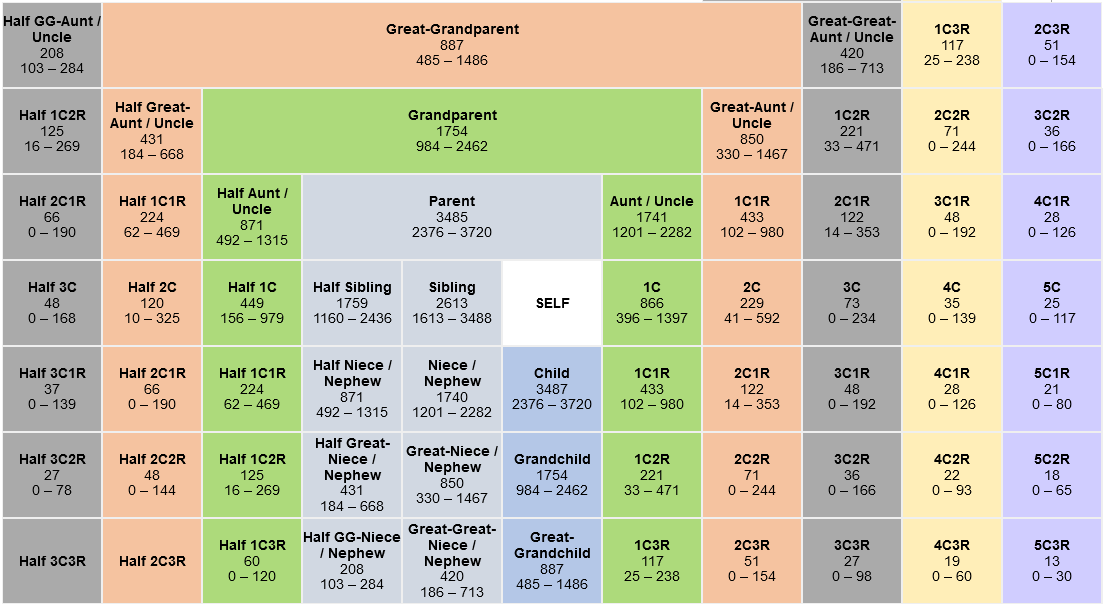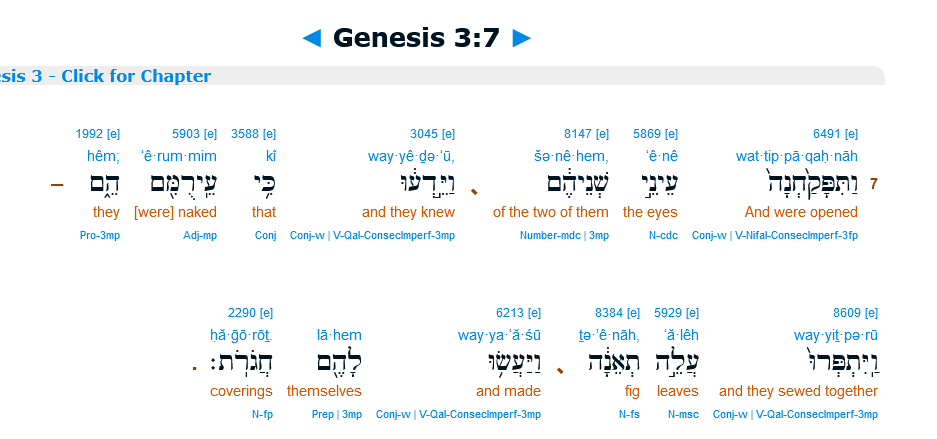Looks like you’re one of the “‘no range’ is more interesting” crowd, eh? ![]()
I was responding to the part in the quote box in that post. Just to clarify, the part I was referring to and additional response below:
" I can’t find the Youtube video now, but I remember the fellow who posted it saying that autosomal DNA (i.e. kind that ancestry.com’s DNA test analyzes) inherited from previous generations tends to disappear [i.e. “fade away”“get watered down”] quickly over descendant generations, so that it’s impossible to confirm a biological relationship between fourth cousins (or was it fifth or sixth cousins)."
Digging deeper, it appears that Ancestry.com looks at “700,000 locations” in the genome, which is a lot more than I suspected. I knew that they used microarray chips, but I was under the impression that the array had far fewer spots than 700,000. Of course, 700k is a tiny percentage of the 6 billion bases in the total diploid human genome, but it’s still a lot for what they are doing.
However, I do wonder how informative those alleles are. I’m not an expert in population genetics or genealogic testing, but my first reaction would be to look for alleles that are physically close to each other which would have been passed on together from a shared ancestor.
Overall, I would expect that the vast majority of people carry some DNA from their great-great-great grandparents. I would also suspect that if you sequenced a large portion of the genome that you could find a very rare allele somewhere in those genomes that would be much more informative than the alleles in the Ancestry.com test. It isn’t so much about dilution of DNA but how rare certain alleles are (again, if I am understanding the science correctly). It’s a bit like not knowing if two people with the last name of Smith are related, but being more sure if hey share an exceedingly rare last name. I happen to have a very uncommon last name, and just about everyone in the US with that last name are related to me. The same would apply to a rare mutation.
Much obliged for the focus re-direct.
700k is enough to keep money-paying common folk genealogists, like me, happier than pigs in slop, … and busier than a swarm of bees.
You do realize “informative” is a very flexible, movable target, don’t you? What Andestry.com, FamilytreeDNA.com, and 23andMe.com offers in the marketplace–which is where the money is–“feeds the multitudes”.
Good luck with that. You can search wherever you want to, but if you’re doing your research in your garage, my guess is that you’re not going have a lot of takers for whatever it is you’re trying to sell. And the folks who have better equipment and finer establishments go where the money is.
Uh, … do you know small those lil’ buggers are?
I’m sorry to say, you’re out of my league. You’ll have to find someone substantially less ignorant than me to confirm your suspicions, modify your expectations, and get you across the river. I can’t.
The “whiz-kids” behind https://www.gedmatch.com/ and over at DNA Detectives may be more helpful.
That is very true. I also give Ancestry.com credit for not overhyping their test results (for the most part).
It is a matter of statistics. If there are 4 common alleles at a specific locus that are shared at a rate of 25% then there is a 1 in 16 chance of two people sharing those alleles by chance.
All of the information you need is on the internet. All you would need is the computer you are currently reading this post on.
The analogy of last names is probably the best I can do. If two people share the name Smith that isn’t the best evidence for them sharing a recent ancestor. However, if their last name is Yrtilla then there is a much higher chance that they share a common ancestor due to the rarity of such a name.
Speaking of “being helpful”, Chang’s proposal involves something called the Binary Logarithm: i.e. log 2^n. My problem is that I don’t know how to enter my numbers into a calculator. Given a “log” key, the number 2, and some number “n”, which do I enter in what order to come up with Chang’s result?
They’re afraid of dissatisfied customers’ lawsuits and lynchmobs.
Easy for you to say. I’m 72, need an aortic valve replacement, and an aortic endovascular stent implant. I could fall out of my chair and be headed for unknown territory any moment now. I don’t multitask well, and the light at the end of the tunnel is bearing down on me fast, there are still cousins in biologos that I haven’t put on my “Ignore” list, and I’m really eager to help Computer Linguistic Programmers solve the mystery of who wrote the books of the Bible attributed to Paul. Plus, there’s good chance that I can date Genesis 3:21 if I can find out when humans developed canine teeth.
Since my initial conjecture evoked such an underwhelming response, I’ve decided to explore an alternative to my “body lice versus head lice” proposal for dating the Fall, … teeth. Rationale?
*
- Given the dubious long-term usability of leaves, God provided skins for Adam and Eve to wear. Skins were more durable, and may have marked human transition from “foraging gatherers” to “meat-eating hunter-gatherers”, eventually leading to farming and husbandry.
- It seems reasonable to me–even if the party-poopers and nay-sayers around here don’t think so–that a change in human diet would involve a corresponding change and effect on human teeth.
- Anybody know, right off hand, when Adam and Eve’s canine teeth came in?
If there is one thing I have always enjoyed in life it is aimless conversations with senior citizens. I think it comes from growing up around both sets of grandparents.
In case you are curious about this stuff at all, there is a gargantuan amount of DNA sequence data available for free in public databases. There are also decent freeware programs that allow you to manipulate sequence data. If you ever want to surf the human genome the UCSC genome browser will supply anything you need.
I centered it on a random gene (Bag1), but you can move to any position in the human genome you want.
ln(x) / ln(2) gives you the log of x in base 2
To check ln(8) / ln(2) = 3
Mammals have had canine teeth for a very long time. Since the Permian per Wikipedia. Might want to go for something else like language or abstract thought. My personal favorite is the establishment of villages. Humans living together in more than a family group would require the development of a lot of social customs and rules.
More the “has found lots of errors in published molecular clocks” crowd (uncritically using rates from organisms with very different lifespans, not checking to see if the oldest record of a group is still placed there, etc.).
Molecular clock dates of 40,000 to 170,000 years may suggest that the event took place somewhere between the present and a few million years ago, but I wouldn’t be too confident.
Although the presence of hominids well outside the tropical regions suggests some sort of supplemental insulation, it is possible that they were growing it rather than manufacturing it, like the elephants and rhinos getting woolly as they moved to colder climates. Peking Man is one of the earlier hominids from an area with cold winters. One might argue that, if clothes weren’t yet in use, why would he bother peeking?

We may have to amend our rules of conduct to disallow bad dad jokes. 
Okay, so molecular clocks are unreliable more (or as) often than not.
Trivia:
A fundamental concept in genetic genealogy is the centimorgan, which is a unit for measuring the genetic linkage. Centimorgan
- One centimorgan equals a one percent chance that a marker on a chromosome will become separated from a second marker on the same chromosome due to crossing over in a single generation. It translates to approximately one million base pairs of DNA sequence in the human genome.
- Centimorgan is named after an American geneticist named Thomas Hunt Morgan. He worked on fruit flies, and he defined the capacity of one part of a genome to separate from another in going from one generation to another. And that’s important because in every generation chromosomes exchange pieces of information, and that’s call recombination. And that’s important for introducing genetic diversity into the population. And it was necessary to define a rate at which this happens, and so that’s where this term centimorgan comes from. “Centi” means just one-hundredth of, and so if a “morgan” represents the total recombination where all markers of one part of a chromosome will become separated from all others, then a centimorgan is the length of DNA over which that happens only one out of a hundred times, or one percent of the time. So one percent recombination equals a centimorgan. It depends on individual genomes what the distance that a centimorgan represents, and in individual genomes is different from fruit flies and zebrafish and bananas and humans, but given the recombination rate in humans, it represents about a million base pairs in the human genome.
- The “The Shared cM Project 4.0 tool v4” is an update of my all-time favorite tool for ascertaining possible biological relationships, if any, between two DNA matches.
- A premise underlying each of the potential biological relationships between two DNA matches is that they share a minimum-to-maximum range of centimorgans. E.g. A biological parent & child share between 2376 and 3720 centimorgans of DNA. Note that that’s one parent-child relationship; but a human child “typically” has two parents. So, it’s reasonable to assume that any human has about 7440 centimorgans of autosomal DNA, i.e. DNA contained in 22 chromosomes–not including the 23rd (sex) chromosome–inherited from both parents.
- For kicks, I offer here actual data for two parents (XY & XX), their two children, and one grandchild.
- XY & XX do not share any DNA.
- XY & Child #1 share 3456 cM.
- XY & Child #2 share 3463 cM.
- XY & Grandchild share 1732 cM.
- XX & Child #1 share 3461 cM.
- XX & Child #2 share 3462 cM.
- XX & Grandchild share 1706 cM.
- The following screenshot of the “The Shared cM Project 4.0 tool v4” page identifies shared cM/biological relationships. Note those biological relationships with “shared cM” ranges that have “0” as the range minimum. (It is my understanding that the ranges are based on actual data submitted previously.)
Many of them are unreliable. There are some that have checked things carefully enough to be likely to be pretty close.
The Molecular Clock and Estimating Species Divergence
- “What is the molecular clock? Levels of molecular variation could be used, in principle, to estimate divergence times, serving as evolutionary “clocks” that “tick” at different rates.”
So, my alternative explanation of the Fall notwithstanding, the divergence of body lice from head lice could yield a basis for my initial conjecture after all. Excuse me while I take that “could” and run with it. IMO, the ball’s in the nay-sayers’ court: prove my conjectural basis wrong. ![]()
The Genesis story doesn’t present the episode as the beginning of clothes-wearing.
If we are curious about dating A & E (and their failure to obey God), then the fact that their sons are farming and shepherding are better indicators. We do know that farming and animal husbandry began roughly 8,000 yrs ago, and there is no problem with that date for A & E provided we don’t make the mistake of supposing they were the first humans and the ancestors of all other humans.
Apparently you and I have different Bibles. Mine has Genesis 2:25; 3:6-7; and 3:21-24.
- 25 Adam and his wife were both naked, and they felt no shame.
- 6 When the woman saw that the fruit of the tree was good for food and pleasing to the eye, and also desirable for gaining wisdom, she took some and ate it. She also gave some to her husband, who was with her, and he ate it. 7 Then the eyes of both of them were opened, and they realized they were naked; so they sewed fig leaves together and made coverings for themselves.
- 21 The Lord God made garments of skin for Adam and his wife and clothed them. 22 And the Lord God said, “The man has now become like one of us, knowing good and evil. He must not be allowed to reach out his hand and take also from the tree of life and eat, and live forever.” 23 So the Lord God banished him from the Garden of Eden to work the ground from which he had been taken. 24 After he drove the man out, he placed on the east side of the Garden of Eden cherubim and a flaming sword flashing back and forth to guard the way to the tree of life.
I see naked people ashamed of their nakedness, covering themselves with leaves sewn together, and then wearing “tunics”–initially given to them by God–made, presumably, of animal skins.
You play in your sandbox your way, and I’ll play in my sandbox my way.
D’ya think so? I don’t.
- Agriculture. Agriculture is the practice of cultivating plants and livestock. Agriculture was the key development in the rise of sedentary human civilization, whereby farming of domesticated species created food surpluses that enabled people to live in cities.
- The word agriculture is a late Middle English adaptation of Latin agricultūra , from ager ‘field’ and cultūra ‘cultivation’ or ‘growing’. While agriculture usually refers to human activities, certain species of ant, termite and beetle have been cultivating crops for up to 60 million years. Agriculture is defined with varying scopes, in its broadest sense using natural resources to “produce commodities which maintain life, including food, fiber, forest products, horticultural crops, and their related services”. Thus defined, it includes arable farming, horticulture, animal husbandry and forestry, but horticulture and forestry are in practice often excluded.
- History of Agriculture– Agriculture, the cultivation of food and goods through farming, produces the vast majority of the world’s food supply. It is thought to have been practiced sporadically for the past 13,000 years, and widely established for only 7,000 years. In the long view of human history, this is just a flash in the pan compared to the nearly 200,000 years our ancestors spent gathering, hunting, and scavenging in the wild."
“We” who? Folks at John Hopkins Center for a Livable Future offer a range from 13,000 to 7,000 years. My guess is that you don’t work at JH’s Center.
Personally, I’m not hung up on specific names. They could have been Ted and Alice for all I care.
As for whether or not Adam & Eve, or Ted & Alice, were the first humans, I don’t think you’re quite ready to define what a human is or what the first of them were like. You might want to wander over to Podcast: Uniquely Unique | What Does It Mean To Be Human? and stay tuned, because I think the jury’s still out, although I happen to have an opinion, which I expressed in that thread.
And, as for whether or not the first folks that everybody decides actually were human were the ancestors of all other humans, I think you’re in for a surprise: Family trees: Tracing the world’s ancestor.



